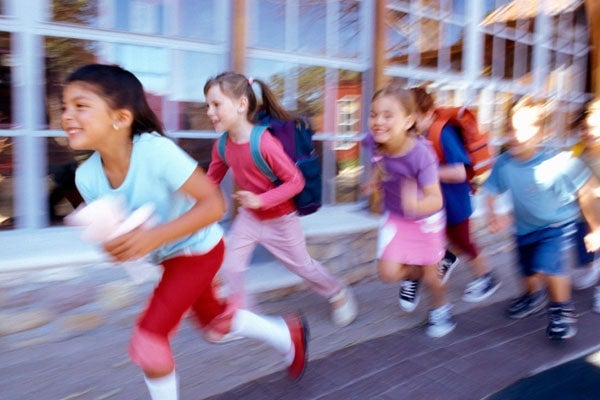
The importance of the walk to school: experts
Published: December 10, 2012
“Walking to school is not dead,” proclaimed Professor Guy Faulkner, as he led a multidisciplinary panel of experts through a public symposium, What Happened to Walking? Encouraging Active School Travel in Toronto.
While Toronto has seen about a 10 per cent decline in the past 20 years, kids who live within one or two kilometres of school are still quite likely to walk, Faulkner told the audience at the Faculty of Kinesiology and Physical Education.
But sprawling city neighbourhoods and perceptions of safety are among the factors that make the trip by foot more difficult, he said.
Faulkner (pictured below left) and colleagues Ron Buliung and Caroline Fusco, who presented highlights of their multi-year study on active school travel, were joined by chief city planner Jennifer Keesmaat and Toronto Star architecture critic and urban affairs columnist Christopher Hume for a discussion about walking to school and how to create an environment more conducive to active travel.
 Funded by the Canadian Institutes of Health Research and the Heart & Stroke Foundation of Canada, the study comes at a time when children are heavier, weaker and less physically-active than they were just five years ago. And results show girls make the trip by foot less often than boys.
Funded by the Canadian Institutes of Health Research and the Heart & Stroke Foundation of Canada, the study comes at a time when children are heavier, weaker and less physically-active than they were just five years ago. And results show girls make the trip by foot less often than boys.
Buliung, a professor of geography at University of Toronto Mississauga, shared adults’ and children’s perspective on safety, which uncovered gender differences and disparities between kids' and parents' fears.
In terms of personal safety, strangers are the biggest fear for parents while their kids seem more concerned about bullies and dogs. But girls consider strangers a threat far more than boys do. And when it comes to traffic safety, both parents and children agree that street crossings are the biggest worry, while parents also factor in cars around the school and the maturity level of their kids.
 Professor Fusco (pictured right) shared the stories of the children themselves, who in addition to being interviewed were asked to take photos of their commute to school. These “photo-voice interviews” highlighted the pros and cons of walking to school, but the most compelling stories were the ones kids told about the benefits beyond physical activity.
Professor Fusco (pictured right) shared the stories of the children themselves, who in addition to being interviewed were asked to take photos of their commute to school. These “photo-voice interviews” highlighted the pros and cons of walking to school, but the most compelling stories were the ones kids told about the benefits beyond physical activity.
One 10-year-old child marvelled at the opportunity to enjoy some small wonders along the way:
“There’s this pathway I go by, and it’s actually in this puny, puny forest. So it has big tall trees around it. Yeah, it’s just spectacular.”
Just months into her role at Toronto’s new chief planner, Keesmaat admitted that in recent years “we’ve designed children out of public space” and says we need to make walking a fundamental part of transportation planning. A passionate advocate for “walking habitats,” Keesmaat identified some great examples in downtown Toronto – where sidewalks include treed boulevards, street-side café culture abounds, and cyclists and transit vehicles share a safe transportation infrastructure. All of these things make walking safer and more enjoyable.
Keesmaat said that under her leadership this model is becoming the gold standard for infrastructure renewal and new neighbourhood planning, adding: “We’re pursuing this pretty aggressively in the city.”
Hume made an impassioned case for the importance of walking in Toronto, insisting that, “Walking is a reflection of how we feel about the environment in which we live.” He marvelled at the need to make a case for the importance of what he called “the most basic human activity” and didn’t pull any punches when it came to Mayor Ford and his infamous statement that, “The war on the car is over.”
Before leading the question-and-answer period, Hume summed up the car travel conundrum: “We live according to the need for convenience. But convenience isn’t really that convenient; we can’t afford it anymore.”
Attended by more than 200 people, the symposium was the fourth in a series of free lectures hosted by the Faculty of Kinesiology and Physical Education to share its diverse areas of research with the broader public. To learn more about the research presented at this symposium, visit the BEAT Project website.
At this time of year, with the snow threatening to fly, the researchers stressed their results also showed that winter does not present a problem for walking to school.
“There’s no such thing as bad weather,” said Faulkner. “Just bad clothing choices.”



